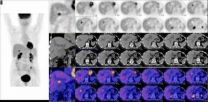(Press-News.org) Des Moines, Iowa USA: World renowned scientists speaking at the World Food Prize Borlaug Dialogue have called for a radical transformation in the agriculture sector to cope with climate change, food security and to transition towards sustainability.
Dr Dennis Garrity, Director General of the World Agroforestry Centre and Professor MS Swaminathan, 1987 World Food Prize Laureate and founder of the MS Swaminathan Research Foundation, have teamed up to promote what they call a 'fresh out of the box solution' which is already dramatically improving crop yields while storing significant carbon.
"Doubling food production by mid-century when so many of the world's soils are depleted and we are faced with a changing climate cannot be achieved with business-as-usual conventional agriculture," Garrity said. "We need to reinvent agriculture in a sustainable and affordable way so that it can adapt to climate change and reduce its emissions of greenhouse gases."
Swaminathan added that "novel solutions and technological advances must be married with ecological thinking to drive a truly sustainable agricultural revolution".
The concept of Evergreen Agriculture, where fertilizer trees are integrated into annual food crop and livestock systems, sustains a green cover on the land throughout the year. It bolsters nutrient supply through nitrogen fixation and nutrient cycling, increases direct production of food, fodder, fuel, and fibre, and provides additional income to farmers from tree products.
In a recent article in the Journal of Food Security, Garrity and co-authors highlight how evergreen agriculture has already provided benefits to hundreds of thousands of farmers in Zambia, Malawi, Niger and Burkina Faso. These farmers are seeing the results of fertilizer trees that draw nitrogen from the air and transfer it to the soil through their roots and leaf litter. Exhausted soils are being successfully restored with richer sources of organic nutrients, and crop yields and incomes are on the rise.
Farmers in Malawi have increased their maize yields by up to 280% when the crop is grown under a canopy of one particular fertilizer tree, Faidherbia albida. Unlike most other trees, Faidherbia sheds its leaves during the early rainy season and remains dormant through the crop-growing period, making it highly compatible with food crops.
In Niger, there are now more than 4.8 million hectares of millet and sorghum being grown in agroforests that have up to 160 Faidherbia trees on each hectare.
Such trees greatly enhance carbon storage both above and below ground compared to conventional agriculture. While estimates of the carbon sequestration potential of agroforestry systems vary greatly - from under 100 Mt CO2e per year to over 2000 Mt CO2e per year over a 30 year period – the IPCC recognizes that the 'transformation of degraded agricultural lands to agroforestry has far greater potential to sequester carbon than any other managed land use change'.
A broad alliance is now emerging of governments, research institutions, and international and local development partners committed to expanding evergreen agriculture. IFAD, the EU, AGRA, the Gates Foundation and UNEP are among those interested in developing partnerships to move the evergreen agriculture agenda forward.
"We are already working with 18 countries across the African continent to develop national plans for implementation of evergreen agriculture," Garrity explained.
The next step is to further refine and adapt the technologies to a wider range of smallholder farming systems in diverse agricultural environments, so that millions of other farmers can benefit for many years, and for generations to come, from such sustainable solutions to their food production challenges.
Swaminathan emphasized the particular need of Africa for an evergreen revolution that increases productivity in perpetuity without causing ecological damage.
"Successful examples of evergreen agriculture from Africa urgently need further research and scaling up to create a real evergreen revolution," Swaminathan said.
"Evergreen agriculture allows us to glimpse a future of more environmentally sound farming where much of our annual food crop production occurs under a full canopy of trees," says Garrity.
###
For more information on evergreen agriculture, visit: http://www.worldagroforestry.org/evergreen_agriculture
END
Babies are curious about nearly everything, and they're especially interested in what their adult companions are doing. Touch your tummy, they'll touch their own tummies. Wave your hands in the air, they'll wave their own hands. Turn your head to look at a toy, they'll follow your eyes to see what's so exciting.
Curiosity drives their learning. At 18 months old, babies are intensely curious about what makes humans tick. A team of University of Washington researchers is studying how infants tell which entities are "psychological agents" that can think and feel.
Research ...
While the blood-brain barrier (BBB) protects the brain from harmful chemicals occurring naturally in the blood, it also obstructs the transport of drugs to the brain. In an article in Nature scientists at the Swedish medical university Karolinska Institutet now present a potential solution to the problem. The key to the BBB is a cell-type in the blood vessel walls called pericytes, and the researchers hope that their findings will one day contribute to new therapies for diseases like Alzheimer's and stroke.
"Our new results show that the blood-brain barrier is regulated ...
Many overseas nurses have negative experiences of living and working in the UK, particularly when it comes to feeling personally valued and professionally respected, according to the October issue of the Journal of Clinical Nursing.
Researchers from the University of Northampton also found that discrimination and racism still exist in the National Health Service and that the reality of first-world UK nursing is often very different to what overseas nurses expect.
Senior lecturer and nurse Julia Nichols and Professor of Neurophysiology Jackie Campbell carried out ...
Scientists at the University of Leeds have perfected a new technique that allows them to make molecular nanowires out of thin strips of ring-shaped molecules known as discotic liquid crystals (DLCs).
The findings could be an important step in the development of next generation electronic devices, such as light-harvesting cells and low-cost biosensors that could be used to test water quality in developing countries.
DLCs are disk-shaped molecules that are one of the more promising candidates for organic electronic devices. However, controlling their alignment has proved ...
Disorganised and emotionally unstable, poorly adapted, suffering from alcohol problems, impulsive, or with a "globally adapted" personality. These are the features of the four diagnosed types of compulsive gamblers identified by researchers at the University Hospital of Bellvitge (IDIBELL) and the Autonomous University of Barcelona (UAB). According to the scientific team, only one of these four shows signs of a significant pathology.
"We need to use different treatments for each sub-group of pathological gamblers in order to respond to their specific therapeutic difficulties ...
BEER-SHEVA, ISRAEL, October 14, 2010 -- A new study by Ben-Gurion University of the Negev (BGU) researchers predicts that a new generation of malware (software written for malicious purposes like identity theft) could steal data on human behavior patterns, which is more dangerous than traditional, detectable attacks.
In the newly published paper, "Stealing Reality," Dr. Yaniv Altschuler and Dr. Yuval Elovici from BGU discuss malware threats that extract personal information about relationships in a real-world social network, as well as characteristic information about ...
Researchers a the University of Granada and the Department of Nuclear Medicine, Hospital Virgen de las Nieves at Granada found that the metabolic imaging diagnosis technique –based on the analysis of a structural analog of glucose labeled with a positron-emitting compound (18F)– allows early diagnosis of gall bladder cancer, a relatively rare disease with high mortality rates among most patients suffering from it.
For the purpose of this study, 62 patients were subjected to this scanning method, which represents the largest sample of patients with gall bladder cancer ...
In the first half of February 2009, two asteroids collided in a region of space beyond the orbit of Mars, as scientists from the Max Planck Institute for Solar System Research (MPS) in Germany have now discovered. The researchers were able to pinpoint the exact date of the impact more precisely than ever before. The debris of the crash had attracted the attention of scientists worldwide. Together with the largest earthbound telescopes and the Hubble Space Telescope, the OSIRIS camera system onboard ESA's space probe Rosetta, that was developed and is now operated under ...
VIDEO:
New research from the Bradley Hasbro Children's Research Center may help clinicians better predict how a child with obsessive compulsive disorder (OCD) will respond to some of the most commonly...
Click here for more information.
EAST PROVIDENCE, RI – New research from the Bradley Hasbro Children's Research Center may help clinicians better predict how a child with obsessive compulsive disorder (OCD) will respond to some of the most commonly used treatment approaches. ...
Scientists at the University of East Anglia have made an important breakthrough in the way anti-cancer drugs are tested.
A tumour cannot grow to a large size or spread until it has developed its own blood supply and leading research has looked for a way of halting capillary formation to stop tumours taking hold.
But new findings published today in the Journal of Cell Science have shown that scientists testing such treatments may not have been studying exactly what they thought they were.
The research proves that cells are able to switch their genetic profile – ...





